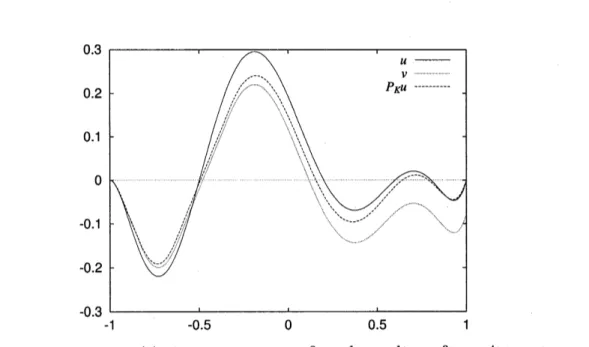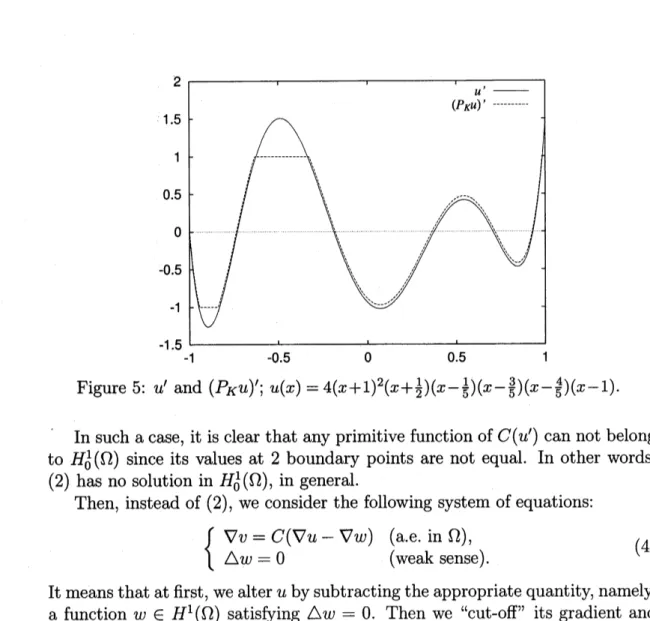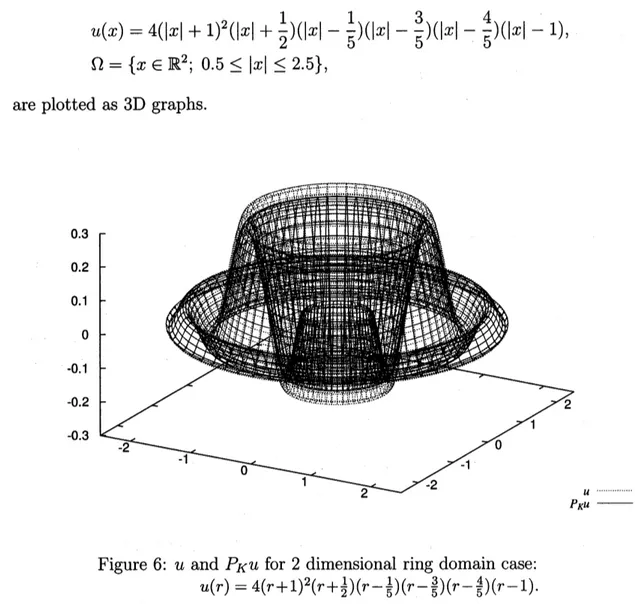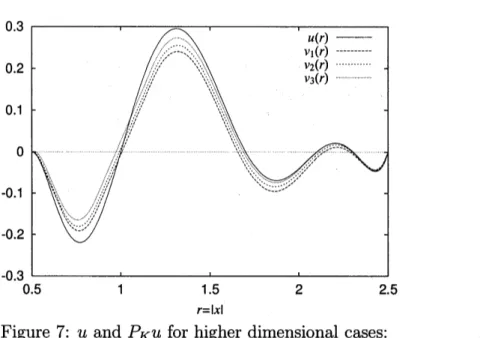On
the
projection
which
appears
in
the
variational
treatment
of
elasto-plastic
torsion
problem
芝浦工業大学システム工学部
井戸川知之 (Tomoyuki Idogawa)
Abstract
In the treatment of variational inequalities, the projection operator
$P_{K}\mathrm{h}\mathrm{o}\mathrm{m}$ some Hilbert space $V$ onto a certain closed convex subset $K$
plays an important role. But, only for few problems, it is known how
to get the explicit form of $P_{K}u$ for each given $u\in V$. In this article,
we consider $K=\{f\in H_{0}^{1}(\Omega);|\nabla f|\leq 1\mathrm{a}.\mathrm{e}.\}$, which is related to
elasto-plastictorsion problems, andpropose aniterative method to approximate
$P_{K}u$ for 1 dimensional case $\Omega=(a, b)$. We also show an expansion of it
for higher dimensional but radial symmetric cases.
1
Problem
Let $\Omega\subset \mathbb{R}^{N}$ be
a
bounded domain witha
smooth boundary and$K:=\{f\in H_{0}^{1}(\Omega);|\nabla f|\leq 1\mathrm{a}.\mathrm{e}.\}$.
We will denote by $P_{K}$ the projection mapping from $H_{0}^{1}(\Omega)$ into its convex closed subset $K$, namely, for $u\in H_{0}^{1}(\Omega)$ and $v\in K$,
$P_{K}u--v= \mathrm{d}\mathrm{e}\mathrm{f}||u-v||H_{0}^{1}(\Omega)=\inf_{f\in K}||u-f||_{H_{0}^{1}(\Omega)}$.
For convenience sake,
we
take$||u||_{H^{1}(\Omega)}0:=|| \nabla u||_{L()}2\Omega=\{\int_{\Omega}|\nabla u(_{X})|2d_{X}\}^{1}/2$ ,
throughout this article. (Note that $\Omega$ is bounded.) The problem is to find
$v=P_{K}u\in K$ for each given $u\in H_{0}^{1}(\Omega)$.
This projection $P_{K}$ appears in the variational treatment of elasto-plastic
Figure 1: cylindrical elastic-plastic bar of
cross
section $\Omega$.
cross
section $\Omega$ to whichsome
torsion momentum ($\tau$ denotes the torsion angle
per unit length) is applied (Fig. 1). It is known that the stress vector $\sigma$ in $\Omega$ is
determined by the minimizer $u$ of
$J(v)= \frac{1}{2}\int_{\Omega}|\nabla v|^{2}d_{X}-\mathcal{T}\int_{\Omega}vdx$ $(v\in K)$,
namely, $\sigma=\nabla u$ [$2$, p.42]. This minimizing problem is equivalent to finding
$u\in K$ such that
$u=P_{K}(u-\rho(Au-\iota))$ for
some
$\rho>0$,where $A\in \mathcal{L}(V, V)$ and $l\in V$ are defined by
$(Af, g)$ $=$ $\frac{1}{2}\int_{\Omega}\nabla f\cdot\nabla_{\mathit{9}}dX$,
$(l, f)$ $=$ $\tau\int_{\Omega}fdx$ $((\cdot, \cdot)$
:
inner product of$V)$ for $f,$ $g\in V:=H_{0}^{1}(\Omega)$, respectively [2, p.3].The projection $P_{K}$ also plays an important role in the
error
estimates of thecorresponding penalized elliptic variational inequalities [5].
2
Rewriting
the problem
We introduce a functional $J_{u}$ : $Karrow \mathbb{R}$ for each given $u\in H_{0}^{1}(\Omega)$:
$J_{u}(f):=||u-f||_{H^{1}(}20 \Omega)=\int_{\Omega}|\nabla u(X)-\nabla f(x)|2dX$. (1)
By using it, the problem can be rewritten such
as
“To find the minimizer $v$ ofProposition 1
If
there exists a solution $v\in H_{0}^{1}(\Omega)$ to$\nabla v=C(\nabla u)$ ($a.e$
.
in $\Omega$), (2)then $v$ is the minimizer
of
$J_{u}$on
$K$, where $C(z):=\{$$z$ $(|z|\leq 1)$,
$z/|z|$ $(|z|>1)$.
Especially, for 1 dimensional
case
$\Omega=(a, b)\subset \mathbb{R}$, put$v(x):= \int_{a}^{x_{C}}(u’(\xi))d\xi$ $(a\leq x\leq b)$ (3)
for
a
given function $u\in H_{0}^{1}(a, b)$. If this function $v(\in H^{1}(a, b)\cap C([a, b]))$satisfies that $v(b)=0$, then $v$ belongs to $H_{0}^{1}(a, b)$ and hence $v=P_{K}u$. An
example of this kind: $u(x)=- \frac{3}{10}\cos(\frac{3}{2}\pi x)$ and $v$ defined by (3) for $\Omega=(-1,1)$
are
shown in Fig. 2. We also plot their derivatives in Fig. 3. In this case, $P_{K}u$and $v$ coincide perfectly (see Fig. 2), and $(P_{K}u)’$ is only the “cut-off” of $u’$,
namely, $(P_{K}u)’=C(u’)$ (see Fig. 3).
Figure 2: the case $v(b)=0;u(x)=- \frac{3}{10}\cos\frac{3}{2}\pi x$.
In fact, for 1 dimensional
case
$\Omega=(a, b)$,one can
easily show that if thegivenfunction $u$ is symmetric (i.e., $u(a+\xi)=u(b-\xi)$ for any $\xi$), then $v$ defined
Figure
3:
$u’$ and $(P_{K}u)’;u(x)=- \frac{3}{10}\cos\frac{3}{2}Tx$.
But it is rather special. We will show
an
example for thecase
$v(b)\neq 0$:$u(x)=4(x+1)^{2}(x+ \frac{1}{2})(x-\frac{1}{5})(X-\frac{3}{5})(x-\frac{4}{5})(x-1)$for $\Omega=(-1,1)$. The graphs
of$u$, corresponding $v$ and $P_{K}u$
are
shown in Fig. 4. Also thederivatives $u’$ and$(P_{K}u)’$ are plotted in Fig. 5.
Figure 5: $u’$ and $(P_{K}u)’;u(x)=4(X+1)2(X+ \frac{1}{2})(x-\frac{1}{5})(x-\frac{3}{5})(X-\frac{4}{5})(x-1)$ .
Insuch acase, it is clear that anyprimitive function of$C(u’)$
can
not belongto $H_{0}^{1}(\Omega)$ since its values at 2 boundary points
are
not equal. In other words,(2) has
no
solution in $H_{0}^{1}(\Omega)$, in general.Then, instead of (2),
we
consider the following system of equations:$\{$
$\nabla v=C(\nabla u-\nabla w)$ ($\mathrm{a}.\mathrm{e}$. in $\Omega$),
$\triangle w=0$ (weak sense). (4)
It
means
that at first,we
alter$u$ by subtracting the appropriate quantity, namely,a
function $w\in H^{1}(\Omega)\mathrm{s}\mathrm{a}\mathrm{t}\mathrm{i}\mathrm{s}\mathfrak{h}\gamma$ing $\triangle w=0$. Then we “cut-off” its gradient andget the primitive function. If the obtained function $v$ belongs to $H_{0}^{1}(\Omega)$, then
the next theorem
assures
that $v=P_{K}u$.Theorem 1 Let$\Omega\subset \mathbb{R}^{N}$ be a bounded domain with smooth boundary.
If
thereexists a solution $(v, w)$ in $H_{0}^{1}(\Omega)\cross H^{1}(\Omega)$ to the system
of
equations (4) with agiven parameter$u\in H_{0}^{1}(\Omega)$, then $v$ belongs to $K$ and minimizes the
functional
$J_{u}$
defined
by (1).(Proof) It is clear that $v\in K$. Hence, it suffices to show that
$\forall f\in K$, $J_{u}(f)-J_{u}(v)\geq 0$.
Let denote $\Omega_{p}:=\{x\in\Omega;|\nabla(u-w)|>1\}$ and $\Omega_{z}:=\Omega\backslash \Omega_{p}$. Fix $f\in K$ and put $\delta:=f-v\in H_{0}^{1}(\Omega)$. For this $\delta$, we
can
easily showsince $|\nabla f|\leq 1$ and $|\nabla v|=1$ ($\mathrm{a}.\mathrm{e}$. in $\Omega_{p}$), and hence
$\nabla\delta\cdot(\nabla u-\nabla w)\leq 0$ ($\mathrm{a}.\mathrm{e}$. in $\Omega_{p}$).
On the other hand, since $\triangle w=0$ (weak
sense
in $H^{1}(\Omega)$) and $\delta\in H_{0}^{1}(\Omega)$,$\int_{\Omega}\nabla\delta\cdot\nabla wdX=\int_{\Omega_{p}}\nabla\delta\cdot\nabla wdX+\int_{\Omega_{z}}\nabla\delta\cdot\nabla wdx=0$.
By using these facts,
we
get$J_{u}(f)-Ju(v)= \int_{\Omega}|\nabla u-\nabla(v+\delta)|^{2}dx-\int_{\Omega}|\nabla u-\nabla v|^{2}dx$
$=$ $\int_{\Omega}|\nabla\delta|^{2}$dx–2$\int_{\Omega}\nabla\delta\cdot(\nabla u-\nabla v)dX$
$=$ $\int_{\Omega}|\nabla\delta|^{2}$dx–2$\int_{\Omega_{p}}\nabla\delta\cdot(\nabla u-\frac{\nabla u-\nabla w}{|\nabla u-\nabla w|})$ dx–2$\int_{\Omega_{z}}\nabla\delta\cdot\nabla wd_{X}$
$=$ $\int_{\Omega}|\nabla\delta|^{2}dX+2\int_{\Omega_{p}}\nabla\delta\cdot(\frac{\nabla u-\nabla w}{|\nabla u-\nabla w|}-\nabla u)dx+2\int_{\Omega_{p}}\nabla\delta\cdot\nabla wdx$
$=$ $\int_{\Omega}|\nabla\delta|^{2}dX+2\int_{\Omega_{\mathrm{p}}}(|\nabla u-\nabla w|-1-1)\nabla\delta\cdot(\nabla u-\nabla w)dX$
$\geq$ $\int_{\Omega}|\nabla\delta|^{2}dX$ $\geq$ $0$.
$\square$
3
1
dimensional
case
Theorem 1
assures
that ifone
could solve the system of equations (4) witha
given parameter $u\in H_{0}^{1}(\Omega)$,
one
get the projection $P_{K}u$. But unfortunately,there may not be any solution to (4) in general, except 1 dimensional
case.
Infact, when $\Omega=(a, b)\subset \mathbb{R}^{1}(-\infty<a<b<\infty)$, the equation $w”=0$
can
besolved such
as
$w’\equiv \mathrm{c}\mathrm{o}\mathrm{n}\mathrm{s}\mathrm{t}$.$\mathrm{a}.\mathrm{e}$. in $(a, b)$. Hence it is sufficient to solve
$v’=c(u’-\alpha)$ ($\mathrm{a}.\mathrm{e}$. in $\Omega$) (5)
for $v\in H_{0}^{1}(a, b)$ and a $\in \mathbb{R}$ instead of (4). And we got an iterative solution
to (5), namely,
an
algorithm to produce the sequences $\{v_{k}\}\subset H^{1}(a, b)$ andAlgorithm I Put $\alpha_{0}:=0$ and iterate thefollowings on $k=0,1,2,$ $\cdots$ . 1.
Define
$v_{k}\in H^{1}(a, b)\cap C([a, b])$ by using $\alpha_{k}$ such as$v_{k}(x):= \int_{a}^{x}C(u(;\xi)-\alpha k)d\xi$ $(a\leq x\leq b)$.
2. Put $\delta_{k}:=\frac{v_{k}(b)}{b-a}$ and $\alpha_{k+1}:=\alpha_{k}+\delta_{k}$.
When $v_{k}arrow v$ in $H^{1}(a, b)$ and $\alpha_{k}arrow\alpha$ in $\mathbb{R}$
as
$karrow\infty$,one can
expect$v(b)=0$, i.e., $v\in H_{0}^{1}(a, b)$. If it holds, the pair of$v$ and a solves to (4). In fact,
these properties
are
assured by the following theorem.Theorem 2 For any $u\in H_{0}^{1}(a, b)$, each sequence $\{\alpha_{k}\}$ and $\{v_{k}\}$ in
Algo-rithm Iconverges. Moreover, the limit
function of
$v_{k}$ belongs to $H_{0}^{1}(a, b)$.Theorem 2 is the direct result of following 3 lemmas. At first, we will prove
the
convergence
of $\{\alpha_{k}\}$ by showing the monotonicity and the boundedness of it.Lemma 1 (monotonicity) In Algorithm $I$,
if
$\alpha_{1}=\delta 0:=\frac{1}{b-a}\int_{a}^{b}C(u’(\xi))d\xi>0$,
then the sequence $\{\delta_{k}\}$
satisfies
that $0\leq\delta_{k+1}\leq\delta_{k}(k=0,1,\mathit{2}, \cdots)$.(Proof) Fix $k\in\{0,1,\mathit{2}, \cdots\}$ and
assume
$\delta_{k}\geq 0$. Let denote$\Omega_{p}(f):=\{x\in\Omega;f(x)>1\}$, $\Omega_{n}(f):=\{x\in\Omega;f(x)<-1\}$,
$\Omega_{z}(f):=\Omega\backslash (\Omega_{p}(f)\cup\Omega_{n}(f))$,
where $\Omega=(a, b)$, and define $\Omega_{ij}$ by
$\Omega_{ij}$ $:=$ $\Omega_{i}(u’-\alpha k+1)\cap\Omega_{j}(u-\alpha_{k}’)$ $(i,j\in\{p, z, n\})$.
For brevity, wewill
use
the notationsNote that
$| \Omega|:=b-a=\sum_{i_{J}},’|\Omega_{ij}|$ and $\sum_{i,j}\omega_{ij}=1$ $(i,j\in\{p, z, n\})$,
and $|\Omega_{pz}|=|\Omega_{pn}|=|\Omega_{zn}|=0$ since $\alpha_{k+1}=\alpha_{k}+\delta_{k}\geq\alpha_{k}$
.
By using them,we
can
write$\delta_{k+1^{-}}\delta k=\frac{1}{|\Omega|}\sum_{i,j}\int_{\Omega_{ij}}\{C(u-\alpha k+1)’-C(u’-\alpha_{k})\}d_{X}$
$=$ $\frac{1}{|\Omega|}\{\int_{\Omega_{z\mathrm{p}}}(u’-\alpha_{k1}+-1)d_{X+}\int_{\Omega_{zz}}(-\alpha_{k}+1+\alpha k)dX$
$+ \int_{\Omega_{np}}(-2)dX+\int_{\Omega}nz(-1-u’+\alpha_{k})d_{X}\}$
$=$ $\frac{1}{|\Omega|}\int_{\Omega_{zp}}(u’-\alpha_{k1}+-1)dx-\omega_{z}z\delta k-2\omega_{np}+\frac{1}{|\Omega|}\int_{\Omega_{nz}}(-1-u’+\alpha_{k})d_{X}$
.
From the definition of $\Omega_{zp}$ and $\Omega_{nz}$, we obtain the following evaluations:
$- \min\{2, \delta_{k}\}\leq u(JX)-\alpha k+1-1\leq 0$ ($\mathrm{a}.\mathrm{e}$. $x$ in $\Omega_{zp}$),
$- \min\{\mathit{2}, \delta k\}\leq-1-u’(X)+\alpha_{k}\leq 0$ ($\mathrm{a}.\mathrm{e}$
.
$x$ in $\Omega_{nz}$).By the estimates from above,
we
get the monotone decreasingness of $\{\delta_{k}\}$:$\delta_{k+1}\leq(1-\omega_{z}z)\delta k-2\omega_{np}\leq\delta_{k}$.
Next,
we
will show the non-negativeness of $\{\delta_{k}\}$. By the estimates from below,we
get$\delta_{k+1}\geq-\min\{\mathit{2}, \delta k\}\omega_{zp}+(1-\omega_{z}z)\delta_{k}-2\omega_{np}-\min\{2,\delta_{k}\}\omega nz$
.
When $\delta_{k}\geq \mathit{2}$,
we can
deduce from this estimate$\delta_{k+1}\geq 2(-\omega zp+1-\omega zz-\omega n\mathrm{P}-\omega_{nz})\geq 0$.
Inthe other hand, when $\delta_{k}<2$,
we can
easily show that $\omega_{np}=0$, andhence$\delta_{k+1}\geq\delta_{k}(-\omega zp+1-\omega_{zzn}-\omega Z)\geq 0$
.
$\square$
Corollary 2 In Algorithm $I$,
if
$\alpha_{1}=\delta_{0}:=\frac{1}{b-a}\int_{a}^{b}C(u’(\xi))d\xi<0$,
then the sequence $\{\delta_{k}\}$
satisfies
that $0\geq\delta_{k+1}\geq\delta_{k}(k=0,1,2, \cdots)$.It is obvious that $\delta_{k}=0$ implies $\delta_{k’}=0$ for all $k’\in\{k, k+1, k+2, \cdots\}$.
Since $\alpha_{k}=\sum_{j=0^{1}}^{k-}\delta j$, it is easy to look that $\{\alpha_{k}\}$ is also monotone and that the
sign of$\alpha_{k}$ is “same”
as
that of$\delta_{k}$ in thesense
considering the signof$0$ to belongto both ofplus and minus
one.
Hence,we
get the following.Corollary 3 For the sequences $\{\delta_{k}\}$ and $\{\alpha_{k}\}$ generated by Algorithm $I$, it
holds that
$\alpha_{k}>0\Rightarrow\delta_{k}\geq 0$ and $\alpha_{k}<0\Rightarrow\delta_{k}\leq 0$ $(k=0,1,\mathit{2}, \cdots)$.
We
use
this property in the proof of Lemma4.
Lemma 4 (boundedness) In Algorithm $I_{f}$ the sequence $\{\alpha_{k}\}$ is bounded
such as
$| \alpha_{k}|\leq(\frac{2}{b-a})^{1/2}||u||_{H_{0}^{1}()}a,b+1$ $(k=0,1,2, \cdots)$.
(Proof) When $u=0$ in $H_{0}^{1}(a, b)$, it is clear that $\alpha_{k}=0$ for any $k\in$
$\{0,1,\mathit{2}, \cdots\}$. Then,
we
take $u\neq 0$, namely, $||u||_{H_{0}^{1}()}a,b=||u’||_{L^{2}}(a,b)>0$. Andwe
will show only for the
case
$\alpha_{k}>0$ here. Almost thesame
proof works for thecase
$\alpha_{k}<0$.For each fixed $\epsilon>0$,
assume
that$\exists k\in \mathrm{N}$ $\mathrm{s}.\mathrm{t}$. $\alpha_{k}\geq(\frac{2+\in}{b-a})^{1/2}||u||_{H_{0}}1(a,b)+1$
.
$(*)$Note that $\delta_{k}\geq 0$ since $\alpha_{k}>0$. Putting
$\Omega_{1}:=\{x\in\Omega;u^{J(}\backslash ^{x})-\alpha_{k}\geq-1\}$, $\Omega_{2}:=(a, b)\backslash \Omega_{1}$,
we
get the inequality$(b-a)\delta_{k}$ $=$ $\int_{\Omega_{1}}C(u^{J}(\xi)-\alpha_{k})d\xi+\int_{\Omega_{2}}C(u(’\xi)-\alpha k)d\xi$
$(\dagger)$
where $| \Omega_{i}|:=\int_{\Omega_{i}}dx$. Since $|\Omega_{2}|=(b-a)-|\Omega_{1}|,$ $|\Omega_{1}|=0$ implies that $\delta_{k}<0$
which contradicts to the assumption $(*)$
.
Then,we assume
$|\Omega_{1}|>0$ hereafter.By using $(*)$ and the definition of$\Omega_{1}$,
we can
easily show that$\xi\in\Omega_{1}\Rightarrow|u’(\xi)|2\geq(\alpha k-1)^{2}\geq\frac{2+\epsilon}{b-a}||u|J|^{2}L2(a,b)$.
Hence, it follows that
$||u’||_{L(}^{2}2a,b) \geq\int_{\Omega_{1}}|u’(\xi)|^{2}d\xi\geq\frac{2+\epsilon}{b-a}||u’||_{L(}^{2}2a,b)|\Omega_{1}|$,
and then,
$|\Omega_{2}|-|\Omega_{1}|\geq\epsilon|\Omega_{1}|$.
This and (\dagger) lead that $\delta_{k}<0$ which contradicts to $(*)$. $\square$
Lemma1 (Corollary 2) andLemma4show theconvergence of$\{\alpha_{k}\}$ generated
by Algorithm I. Then, we will show the convergence of $\{v_{k}\}$ in $H^{1}(a, b)$.
Lemma 5 For $\{\alpha_{k}\}$ and $\{v_{k}\}$ generated by Algorithm $I$, denoting
$\alpha:=\lim_{karrow\infty}\alpha_{k}$ and $v(x):= \int_{a}^{x}C(u’(\xi)-\alpha)d\xi$ $(a\leq x\leq b)$, it holds that $v_{k}arrow v(karrow\infty)$ in$H^{1}(a, b)$ and $v\in H_{0}^{1}(a, b)$.
(Proof) It is easy to see that
$\forall z_{1},$$z_{2}\in \mathbb{R}$, $|C(z_{1})-C(z2)|\leq|_{Z_{1^{-}}}z_{2}|$. By using this property and the definitions of$v$ and $v_{k}$,
we
get$|v’(x)-v’(kX)|=|C(u’(x)-\alpha)-c(u’(x)-\alpha k)|\leq|\alpha-\alpha_{k}|$ ($\mathrm{a}.\mathrm{e}$. in $\Omega$).
Therefore, we obtain
$||v-v_{k}||_{H(\Omega}21):= \int_{a}^{b}|v(x)-v_{k}(X)|^{2}dx+\int_{a}^{b}|v’(x)-v_{k}(\prime X)|^{2}dx$
$=$ $\int_{a}^{b}|\int_{a}^{x}(v’(\xi)-v(\prime k\xi))d\xi|2dx+\int_{a}^{b}|v’(x)-v_{k}(\prime X)|^{2}dx$
$\leq$ $\int_{a}^{b}|\alpha-\alpha_{k}|^{2}(x-a)^{2}dx+\int_{a}^{b}|\alpha-\alpha_{k}|^{2}d_{X}$
and then the
convergence
$v_{k}arrow v$ in $H^{1}(a, b)$. Furthermore, since$|v(b)-v_{k(b)|}$ $=$ $| \int_{a}^{b}(v’(X)-v’k(x))dx|$
$\leq$ $\int_{a}^{b}|v’(x)-v’k(X)|dx\leq|\alpha-\alpha_{k}|(b-a)$,
it holds that $v_{k}(b)arrow v(b)(karrow\infty)$. In the other hand, $v_{k}(b)=\delta_{k}(b-a)=(\alpha_{k+1}-\alpha_{k})(b-a)$
implies $v_{k}(b)arrow 0$, hence
we
get $v(b)=0$, namely, $v\in H_{\mathit{0}}^{1}(a, b)$. $\square$4
Radial symmetric
case
For higher dimensional cases, the system of equations (4) may not have any
solution, in general. But, when both of domain $\Omega$ and given function
$u$
are
radial symmetric, the problem is reducible to 1 dimensional one, and
can
besolved. In this section,
we
consider that both $\Omega$ and$u$
are
radial symmetric.At first, wemention about the most simple (trivial) case, namely, the domain
$\Omega$ is spherical
one:
$\Omega=\{x\in \mathbb{R}^{N};|x|<a\}$ with $0<a<\infty$.
In this case, it is obvious that $v=P_{K}u$
can
be obtained suchas
$v(x):=- \int_{|x|}^{a}C(\tilde{u}(’\rho))d\rho$ $(x\in\Omega)$,
where $\tilde{u}$ : $\mathbb{R}arrow \mathbb{R}$ is defined by $\tilde{u}(|x|):=u(x)$.
For
more
interesting case,we
consider a ring domain:$\Omega=\{x\in \mathbb{R}^{N};a<|x|<b\}$ with $0<a<b<\infty$
.
(6)In this case, the system ofequations (4) can be written as
$\{$
$v_{r}=C(u_{r}-w_{r})$ ($\mathrm{a}.\mathrm{e}$. in $\Omega$), $w_{rr}+ \frac{N-1}{r}w_{r}=0$ (weak sense)
with $r:=|x|$. Since the 2nd equation of this system is solvable such
as
with arbitrary constant $\alpha$, it suffices to solve
$\tilde{v}’(r)=C(\tilde{u}’(r)-\alpha r^{1-N})$ $(\mathrm{a}.\mathrm{e}. r\in[a, b])$ (7)
for $\tilde{v}\in H_{0}^{1}(a, b)$ and $\alpha\in$ R. The equation (7) is similar to (5) and
we can
expand Algorithm I to solve it
as
followings.Algorithm II Put $\alpha_{0}:=0$ and iterate thefollowings
for
$k=0,1,2,$$\cdots$.
1.
Define
$v_{k}(x)$ by using $\alpha_{k}$ such as$v_{k}(x):= \int_{a}|x|C(\tilde{u}’(\rho)-\frac{\alpha_{k}}{\rho^{N-1}})d\rho$ $(x\in\Omega)$.
2. Put $\delta_{k}:=\frac{a^{N-1}}{b-a}\lim_{|x|arrow b}v_{k}(x)$ and $\alpha_{k+1}:=\alpha_{k}+\delta_{k}$.
This algorithm isjustified by the next theorem.
Theorem 3
If
$\Omega$ is a ring domain suchas
(6) and $u\in H_{0}^{1}(\Omega)$ is radialsymmetric one, then $each^{-}sequenCe$
of
$\{\alpha_{k}\}$ and $\{v_{k}\}$ in Algorithm IIconverges.The sequence $\{\alpha_{k}\}$ generated by Algorithm II also has the monotonicity and
the boundedness, and the
convergence
of $\{\alpha_{k}\}$ is direct result of them. Oncethe convergence of $\{\alpha_{k}\}$
was
shown,one can
also show the convergenceof $\{v_{k}\}$.These lemmas written below prove Theorem
3.
Lemma 6 (monotonicity) In Algorithm II,
if
$\alpha_{1}=\delta 0:=\frac{a^{N-1}}{b-a}\int_{a}^{b}C(\tilde{u}’(\rho))d\rho>0$,
then the sequence $\{\delta_{k}\}$
satisfies
that $0\leq\delta_{k+1}\leq\delta_{k}(k=0,1,2, \cdots)$.Lemma 7 (boundedness) In Algorithm II, the sequence $\{\alpha_{k}\}$ is bounded
such as
$| \alpha_{k}|\leq b^{N-1}(\frac{2}{b-a})^{1/2}||\tilde{u}’||L2(a,b)+1$ $(k=0,1,2, \cdots)$.
Lemma 8 For$\{\alpha_{k}\}$ and $\{v_{k}\}$ generated by Algorithm II, denoting
$\alpha:=\lim_{karrow\infty}\alpha_{k}$ and $v(x):= \int_{a}|x|C(\tilde{u}’(\rho)-\frac{\alpha}{\rho^{N-1}}\mathrm{I}d\rho$
$(x\in\Omega)$,
The proofs of Lemma 6,
7
and8 are
done by almostsame
argumentsas
Lemma 1, 4 and 5, respectively, and
we
omit them here.Finally,
we
will showan
example of numerical result of Algorithm II. InFig. 6, $u$ and $P_{K}u$ defined in 2 dimensional ring domain $\Omega$ such
as
$u(x)=4(|X|+1)^{2}(|x|+ \frac{1}{2})(|_{X}|-\frac{1}{5})(|X|-\frac{3}{5})(|X|-\frac{4}{5})(|X|-1)$, $\Omega=\{x\in \mathbb{R}2;0.5\leq|x|\leq 2.5\}$,
are
plottedas
$3\mathrm{D}$ graphs.Figure
6:
$u$ and $P_{K}u$ for 2 dimensional ring domaincase:
$u(r)=4(r+1)2(r+ \frac{1}{2})(r-\frac{1}{5})(r-\frac{3}{5})(r-\frac{4}{5})(r-1)$.
In Fig. 7, the
same
$u$and $P_{K}u$ expressed above but for 1, 2 and 3dimensionaldomains are plotted
as
$r-u$ and $r-P_{K}u$ graphs. One may notice that thediffer-ence
betweenthe valuesof$u$ and those of$P_{K}u$ israther uniform in 1 dimensionalcase.
But ina
higher dimensional case, the difference between the values of $u$$r=|X\mathrm{I}$
Figure
7:
$u$ and $P_{K}u$ for higher dimensionalcases:
$v_{n} \mathrm{d}\mathrm{e}\mathrm{n}u(r)=4\mathrm{o}\mathrm{t}\mathrm{e}\mathrm{s}P_{K}^{+1}(ru)^{2}(r\mathrm{f}_{\mathrm{o}\mathrm{r}n}\dim+\frac{1}{2})(r-\frac{1}{5})(r-\frac{3}{51})\mathrm{e}\mathrm{n}\mathrm{S}\mathrm{i}\mathrm{o}\mathrm{n}\mathrm{a}\mathrm{C}\mathrm{a}\mathrm{s}\mathrm{e}(r-\frac{4}{5}.)(r-1)$ ;
Acknowledgement
The author wishes to express his gratitude to Prof. M. Tsutsumi in Waseda
University for suggesting the problem and for
some
helpfulcommentson
relatedtopics.
References
[1] Y.
C.
Fung, A First Course in Continuum Mechanics (2nd Edt.),Prentice-Hall,
1977.
[2] R. Glowinski, Numerical Methods for Nonlinear Variational Problems,
Springer-Verlag N.Y.,
1984.
[3] W. Han and B. D. Reddy, Plasticity: Mathematical Theory and Numerical
Analysis, Springer-Verlag N.Y.,
1999.
[4] J. Ne\v{c}asand I. Hlav\’a\v{c}ek, Mathematical Theory of Elastic and Elasto-Plastic
Bodies: An Introduction, Elsevier Sci. Pub.,
1981.
[5] M. Tsutsumi and T. Yasuda, Penalty method




